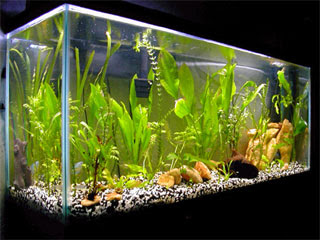Why the Canister Filter Is The Greatest Aquarium Filter Offered
Saturday, August 27, 2011
Other
Aquarium Filters,
Biological Filters,
Canister Filter,
Chemical Filters,
Mechanical Filters
 How do Freshwater Aquarium Filters work?
How do Freshwater Aquarium Filters work?
Any types of aquarium filters really worth its salt really should be able of doing in all a few ways mechanically, biologically and chemically. A fourth way also exists known as germicidal or algaecidal, this type of filtration is usually utilized for a certain purpose like acquiring rid of green drinking water and utilises a UV steriliser.
Large particles like food squander and fish excreta are taken out mechanically by foam and/or fibre filtration media. The filter medium differs in texture from coarse to good, significant particles are eliminated initial by the coarse filter and then modest particles are eliminated by the very good filter.
Two sort of excellent bacteria are used in biological filtration. Fish squander speedily turns into ammonia which is really toxic to the fish. Between the two sorts of bacteria ammonia is transformed to nitrite and then nitrite is converted to the much less toxic nitrate. Drinking water alterations then maintain the nitrate levels down to an acceptable degree.
Activated charcoal or ion trade resins are employed in chemical filters. When the tank is initial setup chemical filtration is needed but it is not usually needed right after that.
The Five Major Types of Aquarium Filters
1) Among the first filters to show up on the market place ended up the in-tank also know as box or corner filters. Most of the modern day filters utilised right now are based upon these filters. They work by pulling water by means of many distinct filter media utilizing an air pump. Compared with other filters available they are not extremely effective but they are reasonable in cost. They are generally utilised today in breeding and hospital tanks.
2). Undergravel filters (UGF) consist of a grid of plastic pipes with tiny holes every 50 % inch or so. A space of drinking water is created underneath the gravel because the grid sits there. Up to four 'air lifts' little by little pull the squander down through the substrate into the pipes. The theory is that bacteria will break it down there. Below gravel filters use an 'air lift' to pull water by way of them so oxygenation is higher other positive aspects are that they are cheap to purchase and straightforward to set up and operate. One disadvantage is that they normally do not do chemical filtration. Also the small holes in the pipes are easily blocked and then squander tends to build up in the substrate. So you have to remove the filter two or 3 times a calendar year to give it a great clean as well as routinely use a siphonic hoover on the gravel. This indicates that you have to remove most of the substrate to get at the filter. For this purpose on your own, undergravel filters are becoming less typical.
3) Electricity filters hang on the exterior of the tank and use a pump to pull h2o up into the filter. The h2o falls again into the aquarium right after getting handed by way of mechanical, biological and quite possibly chemical filter media. These filters are quickly gaining popularity with aquarists due to the fact they are productive, marginally less costly than canisters, and a dream to maintain. Because they are exposed to the air they help oxygenate the drinking water.
4) Wet/dry or trickle filters. They are only integrated for completeness. Their use is normally constrained to quite significant tanks. They are pricey and have been known to empty aquariums of their water if they go mistaken!
5) A much better selection of the top major types of aquarium filters are Canister Filters. A siphon tube connected to a canister and pump pulls water out of the tank and by way of the canister and a return tube places the h2o back again in. Normally the canister consists of coarse ceramic 'donuts' or a coarse fibre, probably some chemical filtration medium like charcoal, porous glass or stone for biological filtration completed with a quite fine filter fibre. A canister filter consequently performs all three kinds of filtering.
 Canister filters are great at maintaining your tank water crystal apparent. The downside to these filters is that they have a tendency to be pricey, use high-priced media, and want to be preserved every month. If they are not maintained properly they can grow to be nutrient traps.
Canister filters are great at maintaining your tank water crystal apparent. The downside to these filters is that they have a tendency to be pricey, use high-priced media, and want to be preserved every month. If they are not maintained properly they can grow to be nutrient traps.
The end result is that nitrogenous waste is pumped again into the tank since of the dirty filter media. Inadequate h2o top quality and algae bloom are induced by it! Also, since canisters are fully closed, they do not oxygenate the h2o so it gets to be essential to include an airstone or possibly a small water pump to agitate the water floor. General though, when correctly taken care of, a great canister filter is difficult to conquer.
Conclusion
It is important that you supply efficient filtration in addition to normal water alterations to quit a toxin construct up which will at some point trigger your fish and plants to die. Canister filters perform filtration by way of a canister chamber that sits typically underneath the fish tank. It is the most costly sort of filter but it performs outstanding filtration. There are a range of different possibilities which have been outlined above. It is your choice.









